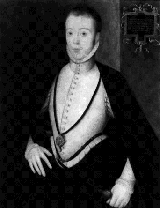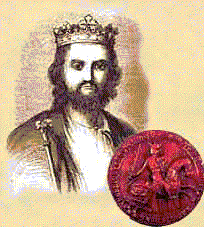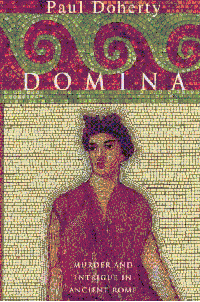|
“For the great Sultan, 500
ducats.
For the King of Spain, 150
ducats including the expenses of the journey, etc.
For the Duke of Milan, 60
ducats.
For the Marquis of Mantua, 50
ducats.
For the Pope, 100 ducats”
John of Ragusa, Professional
Assassin: 1543
The history mystery novel is often put in the dock to face a number
of allegations. The main thrust of the charges is that the writer
takes 20th century phenomena (the victim, the murderer, the detective,
the examination, the pursuit and the conviction) and transports them
back to another era, be it ancient Rome or medieval Britain. Indeed,
the History Mystery faces the same accusation as many historical
films: they are nothing more than costume dramas: 20th Century men and
women wearing funny dresses.
To a certain extent this is true. We all know about the “howlers”
in films: the Roman centurion who wears a Rolex watch; tyre marks in a
western and even a Mercedes has been glimpsed in the background during
a battle between ancient Israelites and Egyptians!
The same can be found in novels. I have read of medieval knights who
“holed up in the hills” or a medieval merchant “walking
along the pavement and seeing something lying in the gutter.”
Medieval knights did not “hole up” in the hills. Pavements
and gutters were a great rarity: most medieval streets were simply a
trackway between over-hanging houses, some of them (and this can still
be seen in Cock Lane near Smithfield in London) had open sewers
running down the middle, which certainly added a certain piquancy to
the early morning air!
 The
old French adage that, “The more things change, the more they
stay the same.” Neatly sums up the defence of historical
mysteries. Murder, like charity, is as old as the hills. The first
crime story must be the killing of Abel by his brother Cain. In the
biblical account, you have a victim, murderer, motive, weapon,
detective and punishment. The sons of Cain are to be detected in every
age and every culture so why can’t the novel bring them out of
the dark? The
old French adage that, “The more things change, the more they
stay the same.” Neatly sums up the defence of historical
mysteries. Murder, like charity, is as old as the hills. The first
crime story must be the killing of Abel by his brother Cain. In the
biblical account, you have a victim, murderer, motive, weapon,
detective and punishment. The sons of Cain are to be detected in every
age and every culture so why can’t the novel bring them out of
the dark?
History mysteries are of two kinds. There are those which are based
on events e.g. Josephine Tye’s ‘Daughter of Time’ which
is a highly enjoyable, fictional investigation into the murder of the
Princes in the Tower in 1483/4. Such mysteries abound simply because
academic historians do not have the evidence to pursue matters to a
logical and satisfactory conclusion. A good example of a history
mystery in our time is the death of John F Kennedy. He was definitely
shot but, the assassination was so cleverly carried out that the list
of possible culprits is both endless and bizarre.
However, the subtle assassination of public figures, is not the
monopoly of the 21st century.  In
1567 Henry Darnley, husband of Mary Stuart, was recuperating in the
royal manor at Kirk o’Fields outside Edinburgh. One evening he
was left with a few of his household when Mary went to attend a
wedding banquet at Holyrood. In the early hours of the morning Kirk o’Fields
was literally lifted off its foundations by a tremendous explosion. It
was feared that Darnley (a complete public nuisance) had died in this
murderous attack. However, Darnley’s corpse was not found amongst
the ruins but a good distance away. He and a page – Taylor –
were found dead in a field, not a mark upon them, both men were in
their nightshirts, nearby were found some rope, a piece of netting, a
dagger and a chair. Immediately an endless list of questions (and
solutions) were posed about the true circumstances of his death and
who was responsible? In
1567 Henry Darnley, husband of Mary Stuart, was recuperating in the
royal manor at Kirk o’Fields outside Edinburgh. One evening he
was left with a few of his household when Mary went to attend a
wedding banquet at Holyrood. In the early hours of the morning Kirk o’Fields
was literally lifted off its foundations by a tremendous explosion. It
was feared that Darnley (a complete public nuisance) had died in this
murderous attack. However, Darnley’s corpse was not found amongst
the ruins but a good distance away. He and a page – Taylor –
were found dead in a field, not a mark upon them, both men were in
their nightshirts, nearby were found some rope, a piece of netting, a
dagger and a chair. Immediately an endless list of questions (and
solutions) were posed about the true circumstances of his death and
who was responsible?
Darnley’s assassination was like that of Kennedy. There were so
many possible culprits, and so many probable
 explanations
that everyone involved, including Mary Stuart, became a potential
suspect. It was what they call in espionage, the looking-glass theory.
Everyone is faced with the facts but these could be easily twisted to
suit anyone’s purposed. Indeed, Darnley’s murder was a
brilliant political coup: it led to the downfall of Mary Stuart and a
savage civil war in Scotland. My theory is that it was the work of
Walsingham’s spies, the successful climax of a long and secret
campaign to discredit Mary, weaken Scotland and bring that country
firmly within the sphere and influence of Elizabeth I. explanations
that everyone involved, including Mary Stuart, became a potential
suspect. It was what they call in espionage, the looking-glass theory.
Everyone is faced with the facts but these could be easily twisted to
suit anyone’s purposed. Indeed, Darnley’s murder was a
brilliant political coup: it led to the downfall of Mary Stuart and a
savage civil war in Scotland. My theory is that it was the work of
Walsingham’s spies, the successful climax of a long and secret
campaign to discredit Mary, weaken Scotland and bring that country
firmly within the sphere and influence of Elizabeth I.
What is so fascinating about studying mysteries like the death of
Darnley or the fate of the Princes in the Tower is that you come
across the assassins. The secret agents and spies who lurked in the
twilight world of dictators, kings, queens and their courts. Men like
John Ragusa whose bill of charges for assassinations introduce this
article. Ragusa was a Franciscan, a 16th century “poisoner will
travel” and his estimate was carefully considered by the Doge and
Council of Venice. In ancient Rome, another poisoner, Locusta was
hired by the opponents of the Emperor Claudius. Locusta was faced with
a real problem: Claudius always insisted that his food and wine be
tasted. Locusta was invited to banquets and studied her potential
victim. In the end she got her man. Claudius, once he had filled his
stomach, liked to vomit and begin again so he used to tickle his
throat with a feather. Locusta poisoned the feather and a successful
contract was completed!
The likes of Locusta and John Ragusa can be found in any court. Many
have seen the film ‘Braveheart’. After Wallace’s death,
Scotland was dominated by Robert the Bruce and his brilliant general
Thomas Randolph, Earl of Moray. In 1332 the great Bruce was dead, his
heir only a boy but Edward III was still confronted by the Earl of
Moray, so he signed a peace treaty with Scotland. There was an
exchange of presents between the courts: Edward III lent Moray the
services of a monk, a skilled physician. Within months Moray was dead
of poison and the physician safely back in England to continue a
profitable medical career generously sponsored by the English crown.
Now, if poisoners and assassins abounded, Princes and Kings also
hired ‘detectives’ to search out the truth. Such individuals
provide the source for the second types of historical mysteries: the
investigator, be he/she public or private. Fictional creations such as
Cadfael, Falco or Sister Fidelima are mirrored by real people. These
real-life detectives were usually of two kinds. The first were monks
or friars. Men like Thomas Dunheved, Edward II’s confessor, who
was sent abroad in 1325 to discover whether Edward’s estranged
Queen Isabella was having an affair with an exiled lord, Roger
Mortimer. The other category were clerks, civil servants, men who
attended the schools at Oxford and Cambridge. Among this illustrious
number are characters such as Christopher Marlowe in the time of
Elizabeth I or John Walwayn who was sent to Berkley Castle in 1327 to
investigate a very successful attempt by a group of paid assassins to
storm the castle and rescue the imprisoned Edward II. Men like Walwayn
kept to the shadows: they were hired, not just because of their
personal loyalty, but also because of their skill in reading, writing,
examination, logic and, in some cases, medical knowledge.
 Nor
must we accept that the women detective was the phenomena of the 19th
or 20th century. In 1322 Edward II hired Mathilda of Westminster
(London’s most skilled physician) to keep an eye on his health
and particularly provide safeguards against poisons (everyone wanted
Edward II dead including the wife!). Or in the 1330’s Cecily of
Oxford was the personal physician of Edward III and often carried out
investigations into suspicious deaths which occurred at court. (Women
were allowed to be physicians until the Act of 1520). There were even
‘Do It Yourself’ books on murder, such as the ‘Book of
Venoms’ published in 1424 which lists the most subtle of poisons
and how to administrate them. So popular did this become that, in
1470, Peter of Albano published another best-seller on antidotes! Nor
must we accept that the women detective was the phenomena of the 19th
or 20th century. In 1322 Edward II hired Mathilda of Westminster
(London’s most skilled physician) to keep an eye on his health
and particularly provide safeguards against poisons (everyone wanted
Edward II dead including the wife!). Or in the 1330’s Cecily of
Oxford was the personal physician of Edward III and often carried out
investigations into suspicious deaths which occurred at court. (Women
were allowed to be physicians until the Act of 1520). There were even
‘Do It Yourself’ books on murder, such as the ‘Book of
Venoms’ published in 1424 which lists the most subtle of poisons
and how to administrate them. So popular did this become that, in
1470, Peter of Albano published another best-seller on antidotes!
In conclusion, if the truth be known. Murder, The Red Handed Slayer
was just as popular in ancient Rome, medieval London or 17th century
Paris as it is today. Of course you might not find this in the history
books but it is the stuff and staple of a good novel! 
|
Chapter 1


‘I shudder as I tell the tale’
Virgil, Aeneid: II.204
Was I in at the end? Naturally! Did I witness her murder? Of course
I did! Did I survive? Well, I am here to tell the tale. Nevertheless,
I sense the hidden meaning behind such questions. Yes, something in me
died with her. I am only glad that, before we parted, she explained
who she really was. I am Parmenon, servant to the Goddess, Domina
Agrippina. When a star falls from heaven it never falls alone. I fell
with her.
They tried to make it look like an accident, but of course it was
murder. The monster Lucius Domitius Ahenobarbus, known as Nero, is a
matricide, was a matricide, will be a matricide as long as time runs.
Truth will out, be it in a blaze of fire or creeping like water
through fissures and cracks. Domina was hardly cold in her grave when
leather bags were hung on Nero’s statue. Do you understand the
significance of that? It means that Nero should be stitched into such
a bag and thrown into the Tiber, the just fate for an assassin! A baby
was abandoned in the forum, with a tag on its cradle reading: ‘I
WON’T MURDER YOU BUT I LEAVE YOU SO WHEN YOU GROW UP YOU WON’T
MURDER ME’.
Domina’s statues were torn down but a wit daubed an inscription
on one of the plinths, a quotation from the Classics: ‘I am
disgraced, but you are ashamed.’ I especially liked one piece of
graffiti for its cleverness: ‘A novel calculation: Nero= slew his
own mother.’A Greek must have written that. (Thank the Gods for
the Classics.) Greek numbers are designated by letters of the
alphabet, so to put it simply: Neron, in Greek, is equivalent to 1005;
the phrase, ‘slew his own mother’ also comes to 1005. Nero
would take some time to work that out, if he ever did.
Others were more blatant. Dartius, a performer of farces, at the end
of one his shows, shouted: ‘Farewell, Father! Farewell, Mother!’
But, instead of waving goodbye at this point, Dartius imitated the
gestures of drunkenness and swimming. It brought the house down though
Dartius had to flee Rome by dead of night. The hypocrite Nero staged
games to mark the death of his ‘Pia Mater’ – Agrippina
had to be mourned. Nero, following the advice of his creature
Anicetus, put on a splendid festival, the climax of which was a
tightrope-walking elephant. Oh Gods, can you imagine it? An elephant
walking a rope? Was that the imperial salute for the daughter of
Germanicus, his own mother?
Let me tell my story from the end rather than the beginning. As in
all things, it takes a woman to destroy another. In Domina’s
case, it was that tasty morsel Poppea, wife of General Otho until she
caught Nero’s eye. Poppea was a ripe grape ready for the
plucking, with her beautiful face and a body so rich you’d groan
at the very sight of it. Poppea the pretty; Poppea the petulant;
Poppea with her sun-gold ring of curls; Poppea the spider; Poppea the
assassin! Poppea was determined to share Nero’s bed. To achieve
that she had to surmount a number of obstacles, which she did with
consummate ease. Now, Poppea could easily remove her own husband as
well as Nero’s wife; after all, in Rome, divorce was as common as
murder. Otho was only too willing to give up his wife, whilst Nero and
Octavia couldn’t stand the sight of each other. Both Octavia and
Otho were quite prepared to leave the stage to the gorgeous, pouting
Poppea, but not Agrippina. A woman who had survived the intrigues of
Caligula, the machinations of Claudius, the murderous malice of
Messalina? Agrippina was made of sterner stuff. Goddesses do not go
into retirement. They either live for ever or die.
So, how do you kill the Queen of Poison? How do you wipe out someone
schooled in the harsh atmosphere of the House of Livia, Augustus’s
great wife? Agrippina knew every poison available. Her cupboards were
full of the antidotes which she regularly took. Poisoning in Nero’s
Rome was becoming virtually impossible. There was a legion of tasters,
not to mention spies, in the kitchen. The principal rule at an
imperial banquet was to eat only from a dish which had been carefully
tasted beforehand. I’ve seen many a glorious supper come to an
abrupt end at the slightest hint of indigestion amongst its guests. So
you can understand Nero and Poppea’s problem. Right from the
start they plotted Domina’s murder. However, whilst selling the
bearskin is easy, trapping and killing its owner, to misquote the
mischievous Petronius, ‘is a different kettle of fish’.
There is always the sword and in the end that’s what it came
to, but how do you bribe someone to kill your mother, an Empress of
Rome? So round and round and round the plotters went. Nero loved his
mother, you’ll say, it must have been difficult for him. Nero
loved nobody! His own father once remarked that anyone who inherited
his and Agrippina’s blood would turn out to be a bad lot. He didn’t
mean it as a prophecy, just a statement of fact. Oh yes, I’ve
heard about the allegations of incest: the tumbling in the litter, the
stains on Nero’s clothing. Just bear with me and I’ll
explain them in due course. It’s the murder we begin with.
Agrippina, may the Gods bless her, suspected it was coming. We were
in the gardens at her favourite villa at Antium. We were sitting, as
we often did, wetting our feet in a fountain, with a bowl of grapes
and a jug of wine between us. Agrippina was tense. She sat, as she
always did when spinning her web, with her shoulders slightly hunched.
A light sheen of sweat glistened on her full face; her black hair was
tied tightly back, except for two corkscrew strands which fell over
the ears. She was talking to herself, lips soundlessly moving. Now and
again she would pause to chew on a grape and squint up against the
sun. It was – is – a beautiful place with raised paths,
greenery, flower beds, splashing water, shadowy porticoes and fragrant
arbours. Just the spot to contemplate your own end.
‘We are all murderers, Parmenon!’ Agrippina’s tone
was meditative, almost as if she was speaking aloud but unaware of
anyone listening.
I could have objected, asked her to explain. It wasn’t the
time. Agrippina turned and yawned, displaying those double canine
teeth. Her lips were purple, grape-stained. I recalled the accusation
that she was blood hungry: a killer born and bred, more ferocious than
any animal in the amphitheatre. Those double canines only enhanced
such a reputation, giving
a slight twist to her lips. Yet this was offset by those lovely,
well-spaced, dark eyes which could crinkle in amusement, flirt
outrageously or glare in murderous passion.
Agrippina was very proud of her eyes. In her youth she used to
remark, ‘Let me stare at a man long enough and he’s mine.’
It wasn’t so much a boast as the truth. I mean, listen to
dramatists talking about characterisation and developing different
personae. It’s nonsense! Most people are simple and boring. Their
lives tend to be dominated by a few questions. How they look? Are they
healthy? Will they earn a lot of money? Are they in or out of favour?
Agrippina was different. You could tell that from her eyes: maternal,
soft and tender, cold and dispassionate, amusing, seductive. Her moods
could change so quickly. Oh, I concede she was dangerous. Any member
of that family was dangerous!
She studied me closely in that lovely villa garden, a faraway look
in her eyes.
‘Do you accept that, Parmenon? That we are all murderers? How
long is my list?’
I gestured with my hand. She flicked a grape at me.
‘Come on, Parmenon, tell me. I know you’ve kept count.’
‘Domina, it’s so long, it would be easier to say who wasn’t
on it!’
Agrippina laughed. My mind was already going through the table of
names. Drusus, starved to death in his prison beneath the Palatine,
reduced to eating the stuffing from his mattress. Sejanus, his
strangled, cat-scratched body thrust into a sack and thrown down the
Stairs of Mourning. Caligula, his plotting senators drawing their
swords, abruptly realising that, despite all the fuss, he really wasn’t
a god.
‘Come on!’ Agrippina urged.
I started to recite the litany. I had only listed seven names when
Agrippina clapped her hands.
© 2002 Headline Reproduced with their kind permission

|